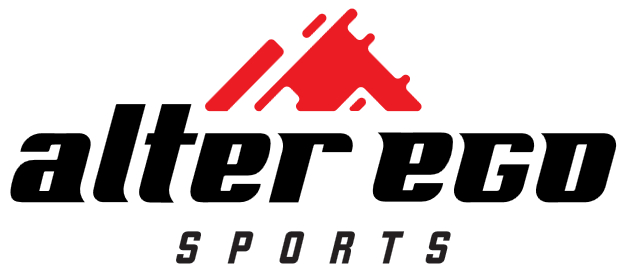Alpine Boot Guide
Ensuring you have a fully compatible ski set up is crucial for proper safety and performance of your gear. This includes ensuring your boots are compatible with your bindings.
The most important factor to consider for ski boots is comfort. Making sure the boot fits snuggly around your foot without any pinching or cramping is a must, as any small discomforts you may feel while trying on the boots will be amped up to 11 when you're out on the hill actually skiing.
In addition to the fit, you should also look out for the compatibility between your boot and your bindings, and the boots stiffness. Both of these will be discussed in much more detail down below.
By the end of this guide you should have a good idea of what you as a skier need out of your boots and what to look for when gearing up for the season.
Anatomy of a Ski Boot
Before we get started, we should figure out the names and functions of all the pieces that make up an alpine ski boot. Refer to the images below to see where everything is, and use the table below that for an explanation of what each of these pieces do.
| Side View | Rear View |
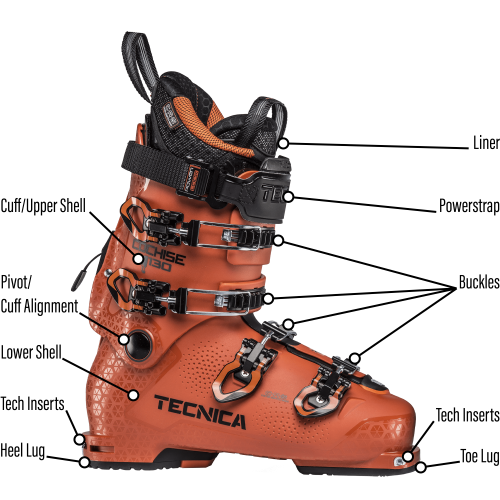 | 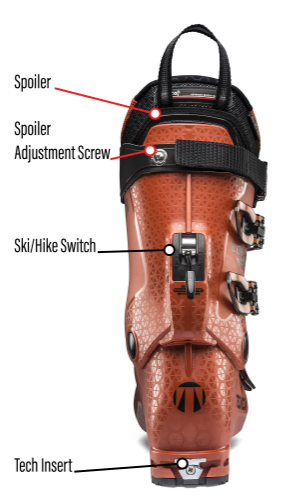 |
| Part | What does it do? |
|---|---|
| Pivot / Cuff Alignment | Also referred to as canting, cuff alignment is the lateral or side-to-side angle of the cuff/upper shell. This allows people with different knee alignments (knock-knee or varus 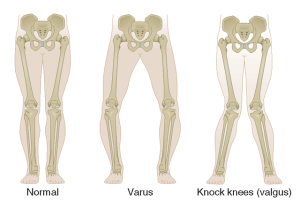 |
| Lower Shell | The plastic backbone of the boot that holds your foot. Often made up of multiple plastics of different densities to achieve proper levels of support around your foot. |
| Cuff/Upper Shell | The plastic backbone of the boot that holds your calf and lower leg. Often made up of multiple plastics of different densities to achieve proper levels of support around your leg. |
| Tech Inserts | These small, metal holes and grooves are found on a variety of different boots, and are used with the super-light tech bindings. Tech inserts are found on the toe area of the boot and on the back of the boot, though inserts on the back are not always present. Although tech inserts follow the tech binding standard, you should always check with an authorized dealer when preparing for a new tech binding set up. |
| Buckles | Most alpine boot buckles have a few different types of adjustment to ensure a nice, tight fit around your foot. The buckle hooks can usually be turned in or out to make the clamp longer or shorter, and the buckle ladders can sometimes be unscrewed and moved into a few different positions to make the fit tighter or looser. |
| Power Strap | Used to tighten the top of the boot around your leg/calf. |
| Liner | The soft layer that provides some cushion and insulation for your foot. Thicker liners tend to be more comfortable and warm, but also heavier. Generally, higher end race boots will have less of an emphasis on comfort and moreso on lightweight performance, meaning a thinner, lighter liner. Most liners are also heat moldable, meaning they can be specially fitted to your foot simply by heating them up and putting them on for 20 minutes. This can only be done once, so second-hand boots cannot be heat molded. |
| Spoiler | The spoiler is a removable wedge on the back of the liner that helps increase the forward lean of the boot and can help fill any gaps for people with smaller lower legs/calves. It can be adjusted by loosening the fixing screw on the back, or can be repositioned if it is held on with velcro. |
| Ski/Hike Switch | Also known as a walk mode switch, this feature of a boot can give a larger degree of movement when in walk or hike mode to allow for easier walking. |
Boot Fitting
There are a few different numbers that will go into your fit, the two important ones are Mondopoint size and last.
How does sizing work?
Ski boots use a specific sizing system called Mondopoint sizing, which is simply the length of your foot in centimetres. Although you can roughly translate street shoe size to Mondopoint, it is best to avoid this. Many people aren't wearing properly sized street shoes, and the sizes aren't always consistent. Alpine boots require a fairly precise fit, since flying down a hill is a bit more demanding than going out for a stroll.
One specific feature of Mondopoint is that half sizes are identical to the full size in every way aside from the insole. For example, a 26.5 and a 26.0 have the exact same shell and liner, the only difference being the insole on the 26.0, which will be thicker than the insole of the 26.5. It is also possible that rather than a thicker insole, the 26.0 will have a piece of felt underneath the insole to achieve the same effect.
The added thickness of the insole raises the foot up and essentially reduces the length and volume of the boot to achieve the half size fit. This saves a ton on cost for manufacturers, allowing them to make half the amount of shells and liners needed for a full size run.
Last refers to the width of the toe box, ranging from around 97 to 107. Alpine lasts do roughly match up to street shoe lasts; 97-98 is about an A or B, 99-103 is about C or D, and anything over 103 is around an E.
How should they fit?
Ski boots should fit pretty tight. You want a snug fit to ensure good power transfer, but you don't want the fit so tight that you lose circulation or start getting pressure points anywhere on your foot. The fit should be consistent all around your foot and leg, and your heel should not lift at all when walking. Heel lift can cause some very painful blisters. Your toes should just barely touch the end of the liner.
The fit of the boot is going to be the tightest when you first try them on in the store. Alpine liners are almost all heat moldable, meaning they will stretch out and conform to the shape of your foot after a few days of riding or after having them heat moulded at your shop. This is one of the advantages to buying over renting, your boots will have a custom fit to your foot, which makes for a very comfortable boot.
How is volume different than last?
The volume of the boot is referring to the overall height and width of the toe area, whereas last is only referring to the width of the toe area. High volume boots are better suited for people with taller than average feet (sometimes due to having high arches) that might hit the top of a regular volume boot, causing pressure points on the top of the foot. Some boots these days come in a few different volumes, such as the Tecnica Mach Sport which comes in low volume, mid volume and high volume.
Can I go to a smaller boot?
Depending on your ability, you may want to go down a half size or even a full size from your actual measurement. Beginners usually stick with their actual measurement, intermediates might go down a half size, and advanced skiers might go as far as a full size down.
The reason for this being that tighter boots are able to transfer power more quickly, giving a better feeling of responsiveness. The downside is that the boot will most likely be less comfortable and more cramped the further you stray from your actual measurement.
Boot Flex
The flex, or stiffness, of your boot plays a very big role in the performance of your setup. This stiffness refers to how hard or easy it is to bend your ankle while wearing the boots. Flex ratings start around 50 and go up to about 130. Low flex ratings are intended for beginner skiers who are descending cautiously and at a slower pace. Higher flex ratings are intended for more advanced skiers who go fast and aggressive.
| Men's Flex | Women's Flex | Stiffness | Style | Speed | Ability |
|---|---|---|---|---|---|
| 70-90 | 50-70 | Soft | Gradual, more gentle descents, just cruising down green and blue groomed runs. | You're going a bit slower than the other people on the hill. | Beginner |
| 90-110 | 70-90 | Average | Exploring most of the mountain, faster blue runs and dabbling with single black diamonds. | You're keeping up with most people on the hill but still getting passed by a few hooligans. | Intermediate  |
| 110-120 | 90-100 | Stiff | You're a strong confident skier looking to challenge yourself with black runs. | You're one of the hooligans flying by pretty much everyone. | Advanced |
| 120+ | 100+ | Very Stiff | You're sending it off the biggest jumps or bombing down double black diamonds. | You're crushing everyone at race-level speeds. | Pro  |
This table is just a guideline for skiers who are an average height and weight. Skiers who are a bit heavier or lighter than average may go up or down in boot flex. Women's boots also tend to be a bit softer than unisex boots to accommodate their lower average weight.
Park skiers are also going to choose their boots a bit differently. If you spend lots of time hitting rails and boxes, a softer boot is generally preferred for more forgiveness.
Boot flex is not an official standard, meaning a flex of 100 from one brand won't be identical to a 100 flex from another brand, but they will be quite similar.
Binding Compatibility
On the bottom of your ski boots is the boot sole, which determines what bindings will be compatible with your boots. Boot soles and bindings must follow very specific guidelines for the dimensions and function, as improperly set up gear can cause serious accidents. For this reason, alpine gear MUST be set up by an authorized dealer. Waxing is the only alpine service you should do on your own. There are two standards for boot soles, ISO 5355 and ISO 9523.
ISO 5355 Boot Soles
ISO 5355 (also known as "alpine boots" or "DIN boots") is the traditional alpine boot sole and comes in two types, Type A (ADULT) and Type C (CHILD). If an ISO 5355 boot has tech inserts on the boot, it will also fit tech bindings.
ISO 5355 - Type A
The adult ISO 5355 Type A sole is compatible with essentially all adult bindings and is the most common alpine ski boot around.
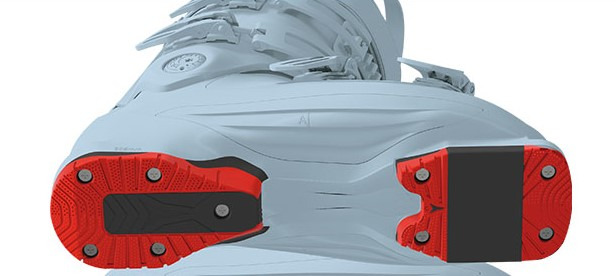
ISO 5355 - Type C
Junior skiers will need ISO 5355 Type C boots, as the Type A (adult) boots have a longer sole length than Type C (child) boots and will not fit into junior bindings.
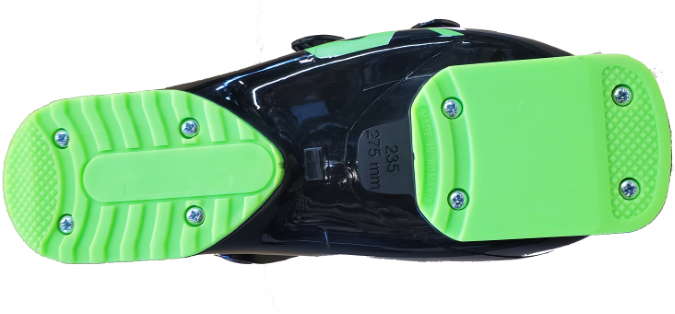
ISO 9523 Boot Soles
ISO 9523 is made up of three main categories; Grip Walk, Walk-to-Ride and regular ISO 9523 soles. These types of boots are intended for touring and are much better suited for walking in thanks to their rockered, rubbery sole. While Grip Walk and Walk-to-Ride meet the ISO 9523 standards, not all ISO 9523 boots meet Grip Walk or Walk-to-Ride standards.
ISO 9523 - Non WTR or Grip Walk
ISO 9523 boots were designed with touring in mind. They will usually feature grippier and rockered soles, and will sometimes have tech inserts to use with tech bindings.

ISO 9523 - Walk-to-Ride
Walk-to-ride boots were meant to be a "crossover" boot between ISO 5355 Alpine and ISO 9523 Touring. WTR has the same geometry as an ISO 9523 Touring sole (which is why the sole is labeled as ISO 9523), however it also features the plastic AFD's found in ISO 5355 soles. In recent years, Grip Walk soles have become much more popular than WTR, making WTR much less common.

ISO 23223-A - Grip Walk
Grip Walk boots have taken over from WTR as the "crossover" boot sole. Grip Walk soles are fairly easy to identify, the boot will have a Grip Walk marking on the toe area of the boot and an ISO 9523 and Grip Walk marking on the sole of the boot. Grip Walk soles have mostly replaced WTR soles on the market, making Grip Walk a more common sole.
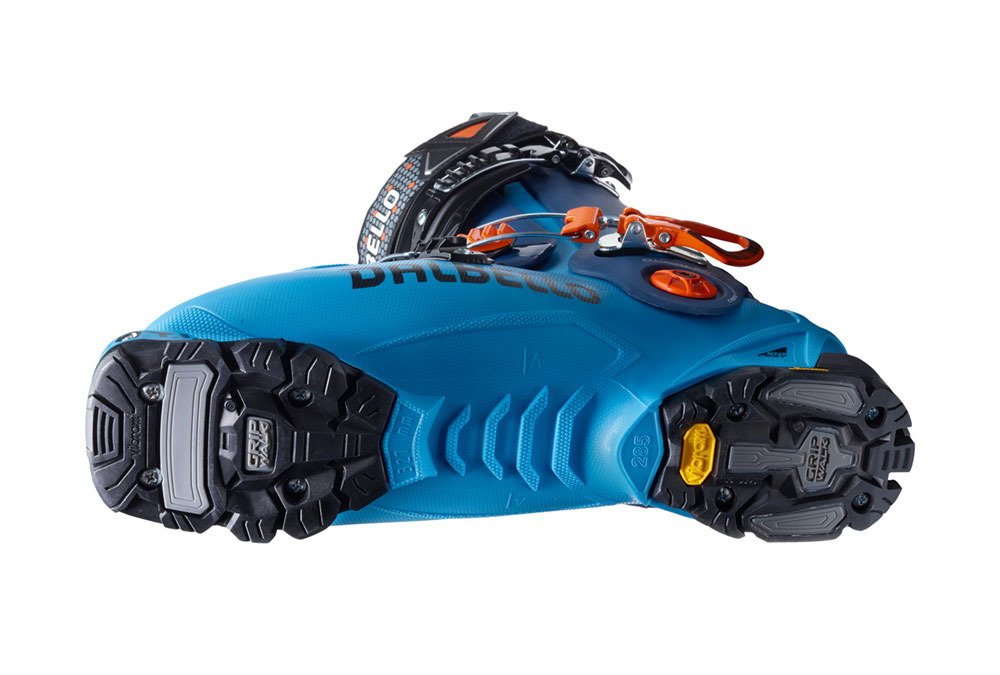
ISO 23223-C - Grip Walk Jr.
Featuring the same super grippy sole as regualr Grip Walk, but meant for the smaller boot sizes of junior skiers.
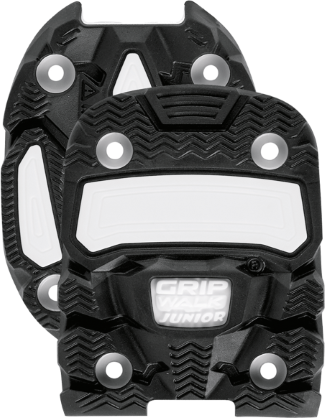
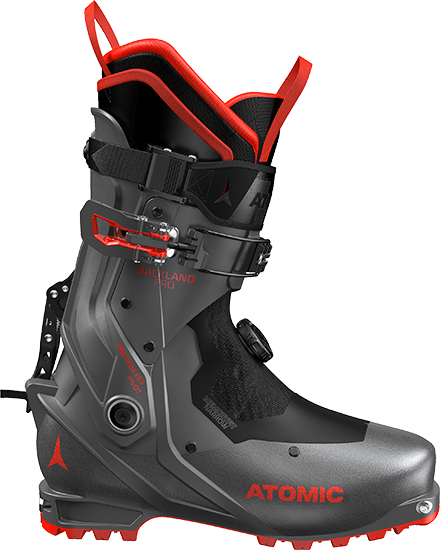
Non-Compliant Touring Boots
Outside of the above standard are the super light, non-ISO compliant touring boots. These boots will only fit with low-tech bindings (a.k.a pin bindings). These bindings all follow the same tech-binding standard.
These boots will usually have fewer buckles than a traditional alpine boot, and may even have Boa retention systems. One of the main goals of these boots is weight reduction, as hiking up mountains is hard enough, and heavy boots can make the ascent even more tiring.
Boot Sole to Binding Compatibility
| ISO 5355 Type A Sole | ISO 5355 Type C Sole | ISO 9523 Sole | Walk-to-Ride Sole | Grip Walk Sole | Grip Walk Jr. Sole | Non Compliant Touring Boots | |
|---|---|---|---|---|---|---|---|
Alpine Binding | YES | - | - | - | - | - | - |
Alpine Jr. Binding | - | YES | - | - | - | - | - |
Alpine AC Binding | YES | YES | - | - | - | - | - |
Alpine AT Binding | YES | - | YES | YES | YES | - | - |
Grip Walk Binding | YES | - | - | - | YES | - | - |
| Grip Walk Jr. Binding | - | - | - | - | - | YES | - |
| Multi Boot Standard (MBS) Binding | YES | - | - | YES | YES | - | - |
| Multi Norm Compatible (MNC) Binding | YES | - | YES | YES | YES | - | - |
| Sole.ID Binding | YES | - | YES | YES | YES | - | - |
| Walk-to-Ride Binding | YES | - | - | YES | YES | - | - |
| Tech Bindings | POSSIBLE* | - | POSSIBLE* | POSSIBLE* | POSSIBLE* | - | POSSIBLE* |
For compatibility marked POSSIBLE*, boots must have tech binding inserts on toe and heel. Compatibility is case-by-case, please contact us for specific compatibility.
For all boot and binding combinations (even those marked as being compatible) installation, set up, testing and maintenance MUST be done by an authorized/indemnified dealer to ensure proper and safe performance.
Keep Learning!
We have more guides to help you learn about all things snowboard and ski!
| Alpine Ski Guide |
| Alpine Boot Guide |
| Alpine Boot to Binding Adjustments |
